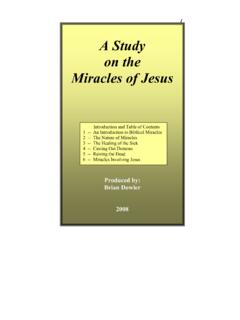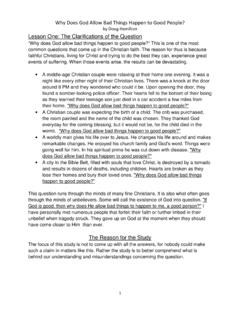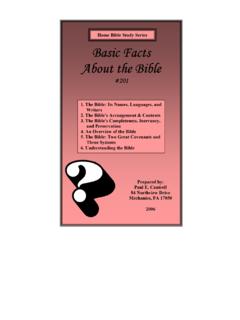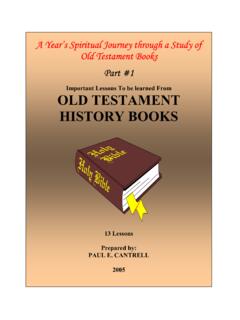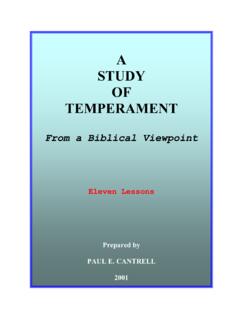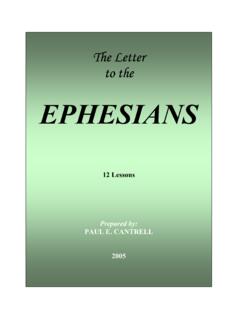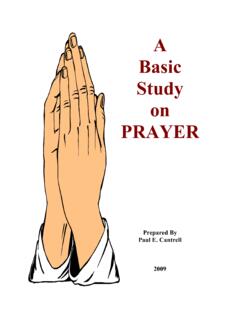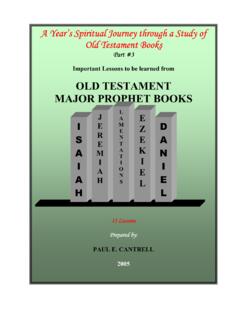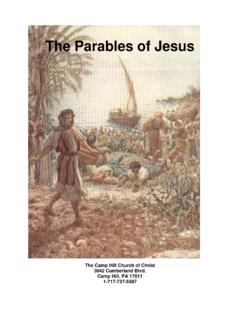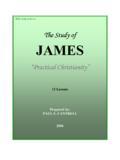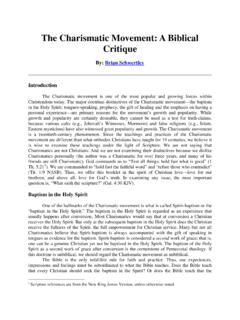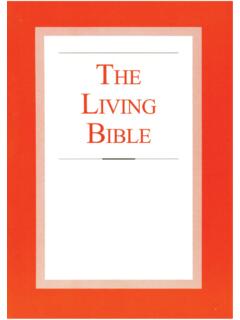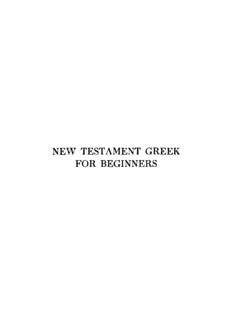Transcription of A Study on 1, 2, 3 JohnJohn - Camp Hill church
1 Bible Study Study Study Study Knowledge, Tr Knowledge, Tr Knowledge, Tr Knowledge, Truth,uth,uth,uth, &&&& Fellowship in Christ Fellowship in Christ Fellowship in Christ Fellowship in Christ A Study on 1, 2, 3 A Study on 1, 2, 3 A Study on 1, 2, 3 A Study on 1, 2, 3 JohnJohnJohnJohn 12 Lessons12 Lessons12 Lessons12 Lessons Prepared by:Prepared by:Prepared by:Prepared by: PAUL E. CANTRELLPAUL E. CANTRELLPAUL E. CANTRELLPAUL E. CANTRELL 2005 Knowledge, Truth, Knowledge, Truth, Knowledge, Truth, Knowledge, Truth, &&&& Fellowship in Christ Fellowship in Christ Fellowship in Christ Fellowship in Christ A Study on 1, 2, 3 JohnA Study on 1, 2, 3 JohnA Study on 1, 2, 3 JohnA Study on 1, 2, 3 John 12 Lessons12 Lessons12 Lessons12 Lessons Prepared by:Prepared by:Prepared by:Prepared by: PAUL E.
2 CANTRELLPAUL E. CANTRELLPAUL E. CANTRELLPAUL E. CANTRELL 84 Northview Drive84 Northview Drive84 Northview Drive84 Northview Drive MechMechMechMechanicsburg, PA 17050anicsburg, PA 17050anicsburg, PA 17050anicsburg, PA 17050 2005 Table of Contents A Study OF 1, 2, 3 JOHN LESSONS TOPICS PAGES 1 -- Introduction to 1, 2, 3 John 1-4 2 -- True Fellowship With God (1:1-10) 5-9 3 -- How Does One Know God? (2:1-14) 10-13 4 -- Love of the World Leads One Away from God (2:15-29) 14-17 5 -- Children of God and Sin (3:1-10) 18-20 6 -- Love from a Pure Heart (3:11-24) 21-23 7 -- God s Children Listen to Him (4:1-6) 24-25 8 -- True Love and its Results (4:7-21) 26-27 9 -- Love, Faith, and God s Witness (5:1-13) 28-31 10-- Prayer and Confident Hope (5.)
3 14-21) 32-34 11-- Abiding in the Doctrine of Christ (2 John) 35-38 12-- How to Walk in Truth (3 John) 39-41 The Study of John 1, 2 & 3 Page 1 Lesson One Introduction to 1, 2, 3 John The handout is to encourage you to Study ahead of time before coming to class. The chapters have been broken down into sections to make it easier to follow. Please make notes of the things you want to discuss. This first lesson is more of an introduction to these three letters of John. AUTHORSHIP OF 1, 2, 3 JOHN It is generally believed that the Apostle John not only wrote these three letters but also the Gospel of John and Revelation. However, John no where states that he is the writer.
4 But there is an abundance of external evidence that verifies his authorship. Time of writing of all five books are generally dated from 80 to 96 AD. OCCASIONS FOR WRITING THESE THREE LETTERS Historical references are made to John being located in the area of Ephesus and of Asia Minor from about 70 AD onward. He probably left Jerusalem about the time of its destruction. He may have been one of the Apostles to help Christians to know when to leave the city. Teachers were arising in the churches who were not content with just the message of the Apostles. The first were the Jewish converts who tried to bind circumcision and the Law on Gentiles. But once the Temple was destroyed this would help to deal with such teachers.
5 But others were also trying to mix their teachings with other philosophies. They also desired to make their own following. John does not name these people, but does give much about them in his writings. He uses such expressions as the following to identify them: False teachers or prophets (4:1) Anti-Christ (2:22-25; 2:18; 4:3; 2 John 7) Deceivers (2 John 7) He strongly indicated that their teachings resulted in the denial of both the Father and the Son (2:22; 2 John 9). These teachers were taking advantage of the hospitality of Christians as they traveled about advocating their doctrines. John said, Try the spirits (1 John 4:1). If they don t bring the true doctrine of Christ don t accept them into your house or bid them God speed.
6 (2 John 10). This and his other writings were for the purpose to help Christians to deal with these false concepts. IDENTIFICATION OF THEIR FALSE TEACHINGS When we compare the writings with early church history we can get a good insight as to what they were teaching and who they were. Paul stated in his letters: That men would arise in midst of church to draw away disciples after them. (Acts 20:28-32) That some would depart from the faith giving heed to doctrines of demons. (1 Tim. 4:1-5). That all of this would eventually lead to a great apostasy. (2 Thess. 2:1-12). The Study of John 1, 2 & 3 Page 2 And history reveals that it was well underway by the last half of the 2nd century.
7 Various names have been connected with these heresies: Cerinthus (who lived in Ephesus the same time John did), Marcion, Valentinus, Arius, Sabellius, Apollinaris, Nestorius, etc., were some of the prominent names among this number. Names have been given to identify these doctrines: Ebionites, Docetists, Arians, Antinomianism, Apollinarians, Nestorians. The general term Gnostic is used to identify these various sects. Gnosticism was really trying to make Christianity conform to the mold of the Oriental, Greek, and Jewish philosophies to be acceptable to them all. Emphasis was placed on knowledge The knowing ones. The Greek word means knowledge. They exalted their knowledge and insights above the Apostles.
8 There was an arrogance, pride, superior intellectual attainments pointed out by these false teachers. INDICATIONS IN PAUL S WRITINGS The Apostle Paul wrote much earlier than John (Possibly 52-67 AD). But there were indications in some of his letters that the churches were already having to face up to this admixture of doctrines that John dealt very strongly with. Following are some indications: 1. 1 Corinthians: a) Exaltation of man s wisdom. (Chs. 1-2) b) Fleshly indulgences. (Chs. 3,6) c) Denial of the Resurrection. (Ch. 15) 2. Colossians: a) Philosophy, vain deceit, tradition of men, rudiments of the world. (2:8) b) Worshipping of angels. (2:18) c) Abstinence. (2:21-23) d) Binding of the Law of Moses.
9 (2:16) 3. 1 & 2 Timothy, Titus: a) Fables, endless genealogies, vain janglings. (1 Tim. 1:3-6) b) Departures, asceticism, abstinence. (1 Tim. 4:1-5) c) Science falsely so-called. (1 Tim. 6:20) d) Predictions. (2 Tim. 3:1-8) e) Turned to fables. (1 Tim. 4:1-4) f) Jewish fables, commandments of men, professed they know God, but in works deny Him. (Tit. 1:14-16) g) Foolish questions, genealogies, contentions, strivings about the Law heretics. (Tit. 3:9-11) All five of John s works (1, 2, 3 John, Gospel of John, and Revelation) indicate similar and further growth of these false teachings. The Study of John 1, 2 & 3 Page 3 BASIC TEACHINGS OF THE GNOSTICS 1. They advocated that the world was created by a lesser Deity, who was a fallen spirit (generally identified with the God of the ) 2.
10 Man s body which is matter is evil! 3. But God s Spirit was breathed into his body that kept him from being totally evil. 4. Sin was defined as ignorance of man s true condition (Christian Science approach). 5. Salvation was to possess a true knowledge of the Gnostic Gospel. a) When a person was baptized, he could become enlightened. b) He is spiritually resurrected becomes spiritual. 6. They denied the bodily resurrection of man. 7. Sin was thus a matter of indifference. a) It is not the body, but the spirit that is saved. b) It doesn t matter what the body does This led to licentiousness. 8. Asceticism was a means of spiritually communing with God. 9. At death this knowledge of the Gnostic Gospel allowed the spirit to return to the spirit world.
